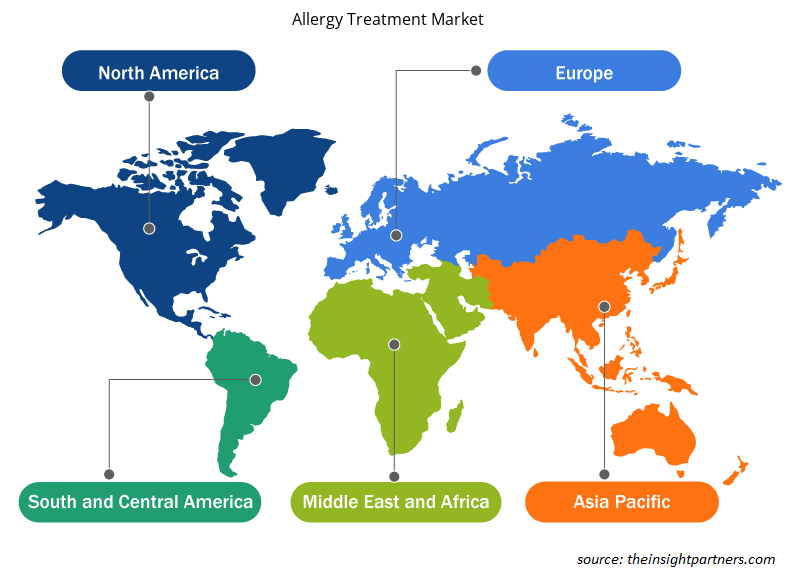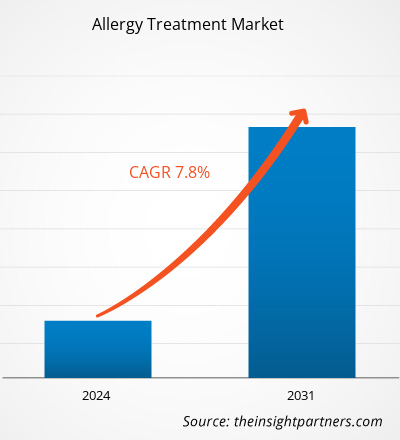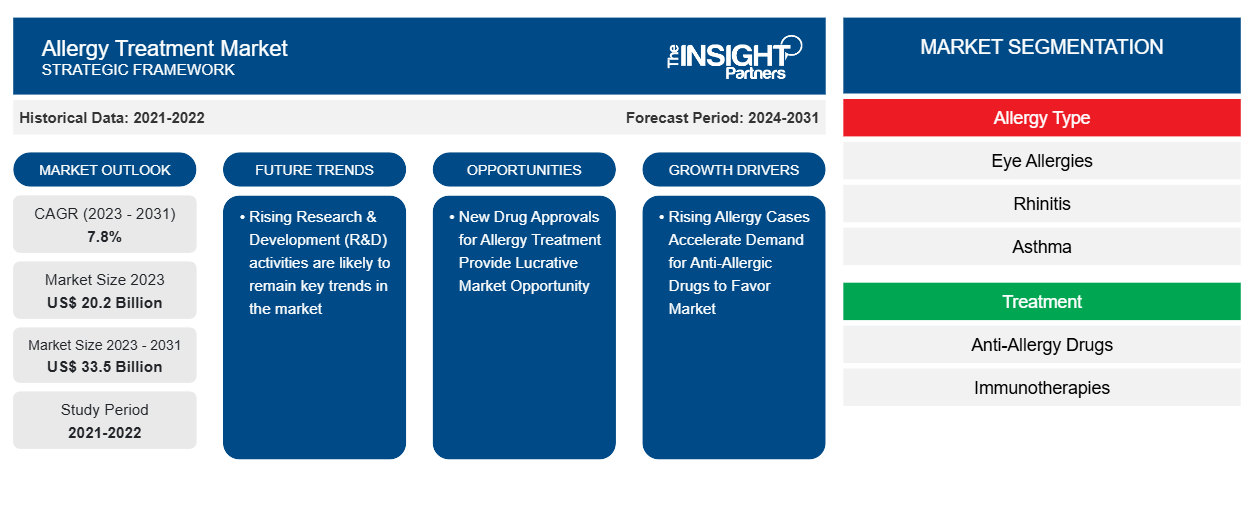Se proyecta que el tamaño del mercado de tratamiento de alergias alcance los 33 500 millones de dólares estadounidenses en 2031, frente a los 20 200 millones de dólares estadounidenses en 2023. Se espera que el mercado registre una CAGR del 7,8 % durante el período 2023-2031. Es probable que las crecientes actividades de investigación y desarrollo (I+D) sigan siendo tendencias clave en el mercado.
Análisis del mercado de tratamientos para las alergias
Es probable que el aumento de las actividades de I+D para el tratamiento de las alergias con el fin de desarrollar fármacos innovadores siga siendo una nueva tendencia del mercado en los próximos años. A pesar de que existen varios medicamentos para las alergias en el mercado, muchos pacientes con alergias respiratorias y asma todavía no están adecuadamente controlados o reciben un tratamiento insuficiente con terapia sintomática. Por ejemplo, varias alergias respiratorias suponen un riesgo de desarrollar asma. Por lo tanto, varios fabricantes importantes están diseñando programas de ensayos clínicos para alergias. Las "Inmunoterapias con alérgenos" de HAL Allergy BV para alergias respiratorias para un ensayo clínico es un ejemplo. Por lo tanto, el aumento de las actividades de I+D dará como resultado el desarrollo de nuevos medicamentos antialérgicos que representarán un crecimiento considerable del mercado durante 2021-2031.
Descripción general del mercado de tratamiento de alergias
Según el informe de la Clínica de Alergias y Asma, los nuevos datos publicados por la Organización Mundial de Alergias (WAO) revelan que el 14% de las personas padecen asma y el 20% padece rinitis alérgica (AR), que se produce por una inflamación de la mucosa nasal mediada por IgE . En la actualidad, alrededor del 20-30% de la población de la India padece una o más enfermedades alérgicas, y la prevalencia aumentará en los próximos años. Por lo tanto, el aumento de los casos de alergias acelerará la demanda de fármacos antialérgicos en la próxima década.
Personalice este informe según sus necesidades
Obtendrá personalización en cualquier informe, sin cargo, incluidas partes de este informe o análisis a nivel de país, paquete de datos de Excel, así como también grandes ofertas y descuentos para empresas emergentes y universidades.
-
Obtenga las principales tendencias clave del mercado de este informe.Esta muestra GRATUITA incluirá análisis de datos, desde tendencias del mercado hasta estimaciones y pronósticos.
Factores impulsores y oportunidades del mercado de tratamiento de alergias
El aumento de casos de alergia acelera la demanda de medicamentos antialérgicos para favorecer el mercado
Según el informe de la Academia Estadounidense de Pediatría, el tipo más común de alergia es la fiebre del heno (rinitis alérgica), que representa el alto costo del tratamiento. Por ejemplo, los costos directos e indirectos superan los 7 mil millones de dólares anuales para el tratamiento de la alergia. Por lo tanto, un buen tratamiento de la alergia se basa en el historial médico, los resultados de las pruebas de alergia y en si los síntomas son leves o graves. Además, la inmunoterapia es una opción de tratamiento eficaz para algunos pacientes alérgicos. Hay dos tipos comunes de inmunoterapia. Estos incluyen inyecciones para la alergia e inmunoterapia sublingual (SLIT). Las inyecciones para la alergia incluyen la administración de alérgenos con una dosis que se incrementa con el tiempo. Además, la persona se vuelve progresivamente menos sensible a ese alérgeno, ya que estas inyecciones pueden funcionar bien para algunas personas con alergias al polen, mascotas, polvo, abejas y otros insectos que pican, así como asma. Por lo tanto, el aumento de los casos de alergia acelera la demanda de medicamentos antialérgicos que actúan como los principales impulsores de la participación en el mercado mundial de tratamiento de alergias.immunotherapy is an effective treatment option for some allergy patients. There are two common types of immunotherapy. These include allergy shots and sublingual immunotherapy (SLIT). Allergy shots include giving injection of allergens with; an increasing dose over time. Also, the person progressively less sensitive to that allergen as these shots can work well for some people with allergies to pollen, pets, dust, bees, and other stinging insects, as well as asthma. Therefore, rising allergy cases accelerate demand for
Las nuevas aprobaciones de medicamentos para el tratamiento de las alergias ofrecen una oportunidad de mercado lucrativa
Las nuevas aprobaciones de medicamentos para tratar las alergias brindarán una oportunidad de mercado lucrativa para el mercado de tratamientos para las alergias. En junio de 2020, Cadila Pharmaceuticals Limited anunció el lanzamiento de "Bilastine Syrup (30 ml)" y tabletas de Bilastine de 20 mg. Además, en marzo de 2022, Perrigo Company plc anunció que recibió la aprobación final de la FDA de los EE. UU. para el uso sin receta (OTC) de "Nasonex® 24HR Allergy (furoato de mometasona monohidrato 50 mcg)". La aprobación marca el primer cambio de marca de Rx a OTC para la empresa para "Nasonex" que ingresa al mercado de OTC.Cadila Pharmaceuticals Limited announced the launching of "Bilastine Syrup (30ml)" and Bilastine Tablets of 20mg strength. Additionally, in March 2022, Perrigo Company plc announced receiving final approval from the USFDA for over-the-counter (OTC) use of "Nasonex® 24HR Allergy (mometasone furoate monohydrate 50mcg)". The approval marks the first branded Rx-to-OTC switch for the company for "Nasonex" to enter the OTC marketplace.
Análisis de segmentación del informe de mercado de tratamiento de alergias
Los segmentos clave que contribuyeron a la derivación del análisis del mercado de tratamiento de alergias son tipo, causa, tipo de trastorno, categoría y usuario final.
- Según el tipo de alergia, el mercado de tratamiento de alergias se segmenta en alergias oculares, rinitis, asma, alergias cutáneas, alergias alimentarias y otras. El segmento de la rinitis tuvo una mayor participación de mercado en 2023.
- Por tratamiento, el mercado se segmenta en medicamentos antialérgicos e inmunoterapias. El segmento de medicamentos antialérgicos tuvo la mayor participación del mercado en 2023.
Análisis de la cuota de mercado de los tratamientos para las alergias por geografía
El alcance geográfico del informe de mercado de Tratamiento de alergias se divide principalmente en cinco regiones: América del Norte, Asia Pacífico, Europa, Medio Oriente y África, y América del Sur y Central.
América del Norte ha dominado el mercado. En la región de América del Norte, Estados Unidos representa la mayor participación en el mercado de tratamiento de alergias. La presencia de los principales fabricantes en la región y sus innovadores medicamentos antialérgicos con una actividad farmacológica eficaz son los factores que contribuyen al dominio del mercado. Se prevé que Asia Pacífico crezca con la CAGR más alta en los próximos años.
Perspectivas regionales del mercado de tratamiento de alergias
Los analistas de Insight Partners explicaron en detalle las tendencias y los factores regionales que influyen en el mercado de tratamiento de alergias durante el período de pronóstico. Esta sección también analiza los segmentos y la geografía del mercado de tratamiento de alergias en América del Norte, Europa, Asia Pacífico, Oriente Medio y África, y América del Sur y Central.

- Obtenga datos regionales específicos para el mercado de tratamiento de alergias
Alcance del informe de mercado sobre tratamiento de alergias
| Atributo del informe | Detalles |
|---|---|
| Tamaño del mercado en 2023 | US$ 20,2 mil millones |
| Tamaño del mercado en 2031 | US$ 33.5 mil millones |
| CAGR global (2023 - 2031) | 7,8% |
| Datos históricos | 2021-2022 |
| Período de pronóstico | 2024-2031 |
| Segmentos cubiertos |
Por tipo de alergia
|
| Regiones y países cubiertos |
América del norte
|
| Líderes del mercado y perfiles de empresas clave |
|
Densidad de actores del mercado: comprensión de su impacto en la dinámica empresarial
El mercado de tratamientos para las alergias está creciendo rápidamente, impulsado por la creciente demanda de los usuarios finales debido a factores como la evolución de las preferencias de los consumidores, los avances tecnológicos y una mayor conciencia de los beneficios del producto. A medida que aumenta la demanda, las empresas amplían sus ofertas, innovan para satisfacer las necesidades de los consumidores y aprovechan las tendencias emergentes, lo que impulsa aún más el crecimiento del mercado.
La densidad de actores del mercado se refiere a la distribución de las empresas o firmas que operan dentro de un mercado o industria en particular. Indica cuántos competidores (actores del mercado) están presentes en un espacio de mercado determinado en relación con su tamaño o valor total de mercado.
Las principales empresas que operan en el mercado del tratamiento de alergias son:
- Servicios Johnson y Johnson, Inc.
- Sanofi
- AbbVie, Inc. (Allergan plc)
- Pfizer, Inc.
- LETIPharma
- ALK-Abello A/S
Descargo de responsabilidad : Las empresas enumeradas anteriormente no están clasificadas en ningún orden particular.

- Obtenga una descripción general de los principales actores clave del mercado de tratamiento de alergias
Noticias y desarrollos recientes del mercado de tratamiento de alergias
El mercado de tratamiento de alergias se evalúa mediante la recopilación de datos cualitativos y cuantitativos posteriores a la investigación primaria y secundaria, que incluye publicaciones corporativas importantes, datos de asociaciones y bases de datos. A continuación, se enumeran algunos de los desarrollos en el mercado de tratamiento de alergias:
- En febrero de 2024, Novartis anunció la aprobación de "Xolair (omalizumab)" por parte de la Administración de Alimentos y Medicamentos de Estados Unidos (FDA). El producto recién lanzado se utiliza para reducir las reacciones alérgicas, incluida la anafilaxia, que se producen por exposición accidental a uno o más alimentos en pacientes adultos y pediátricos de 1 año o más con alergia alimentaria mediada por IgE. (Fuente: Novartis, sitio web de la empresa, febrero de 2024)
Informe sobre el mercado de tratamiento de alergias: cobertura y resultados
El informe “Tamaño y pronóstico del mercado de tratamiento de alergias (2021-2031)” proporciona un análisis detallado del mercado que cubre las siguientes áreas:
- Tamaño del mercado de tratamiento de alergias y pronóstico a nivel mundial, regional y nacional para todos los segmentos clave del mercado cubiertos bajo el alcance
- Tendencias del mercado de tratamiento de alergias, así como dinámica del mercado, como impulsores, restricciones y oportunidades clave
- Análisis detallado de las cinco fuerzas de Porter y PEST y FODA
- Análisis del mercado de tratamiento de alergias que cubre las tendencias clave del mercado, el marco global y regional, los principales actores, las regulaciones y los desarrollos recientes del mercado.
- Panorama de la industria y análisis de la competencia que abarca la concentración del mercado, análisis de mapas de calor, actores destacados y desarrollos recientes para el mercado de tratamiento de alergias
- Perfiles detallados de empresas
- Análisis histórico (2 años), año base, pronóstico (7 años) con CAGR
- Análisis PEST y FODA
- Tamaño del mercado, valor/volumen: global, regional y nacional
- Industria y panorama competitivo
- Conjunto de datos de Excel
Informes recientes
Testimonios
Razón para comprar
- Toma de decisiones informada
- Comprensión de la dinámica del mercado
- Análisis competitivo
- Información sobre clientes
- Pronósticos del mercado
- Mitigación de riesgos
- Planificación estratégica
- Justificación de la inversión
- Identificación de mercados emergentes
- Mejora de las estrategias de marketing
- Impulso de la eficiencia operativa
- Alineación con las tendencias regulatorias























 Obtenga una muestra gratuita para - Mercado de tratamientos para alergias
Obtenga una muestra gratuita para - Mercado de tratamientos para alergias